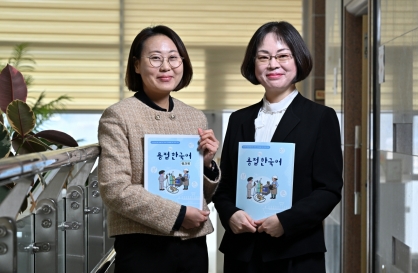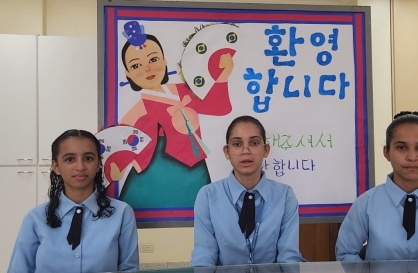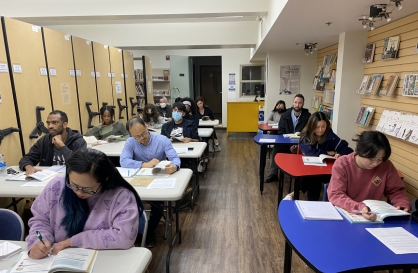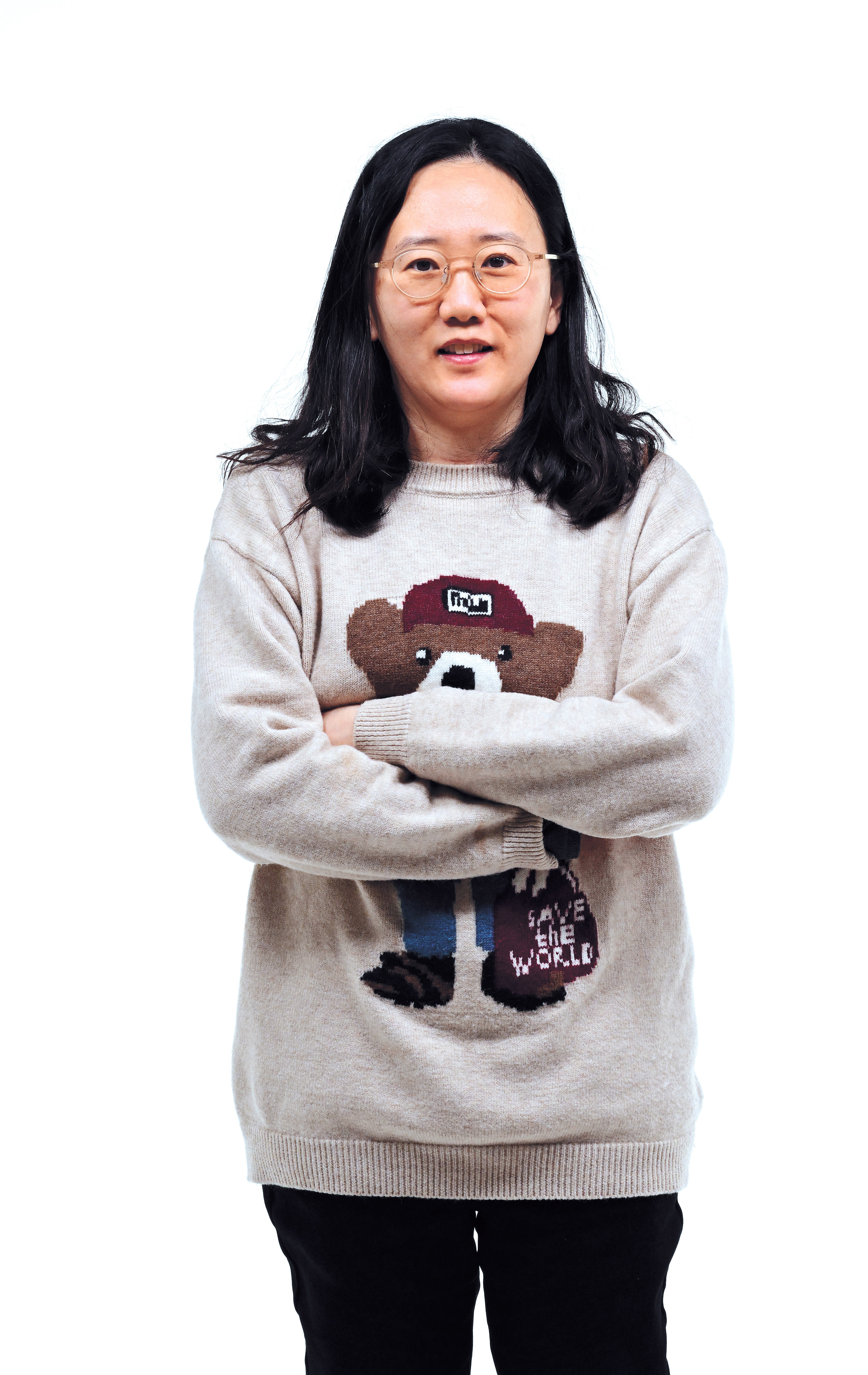Most Popular
Hello Hangeul
-
1
Welding book first in vocational Korean series for foreign labor

-
2
[Korea Beyond Korea] In Sao Paulo, horizons expand for Korean studies
![[Korea Beyond Korea] In Sao Paulo, horizons expand for Korean studies](//res.heraldm.com/phpwas/restmb_idxmake.php?idx=644&simg=/content/image/2023/11/20/20231120000619_0.jpg&u=20231206104853)
-
3
In Brasilia, worldly dreams are born from Korean classes

-
4
Americans seeking to visit Korea learn the language in LA

-
5
[Korea Beyond Korea] Berlin, Europe's Korean Studies hub, nurtures next-gen experts, scholars
![[Korea Beyond Korea] Berlin, Europe's Korean Studies hub, nurtures next-gen experts, scholars](//res.heraldm.com/phpwas/restmb_idxmake.php?idx=644&simg=/content/image/2023/10/18/20231018000929_0.jpg&u=20231023154735)
[Hello Hangeul] Sharing the Korean alphabet with the world
Cia-Cia to Korean dictionary published after 10 years of work
By Kim So-hyunPublished : April 2, 2023 - 17:03

King Sejong the Great invented Hangeul in 1443 with the goal of increasing literacy among commoners who had few chances to learn the logographic hanja, or Chinese characters.
Out of respect for the king's democratic intention and love for humanity, several projects were launched from the late 1990s onward to share the Korean alphabet with ethnic minorities in Asia, Africa and South America that did not have their own writing systems. Without a script, their languages were at the risk of disappearing, along with their oral cultures.
But today, many of these projects no longer exist. This situation demonstrates that it takes more than just linguists and the goodwill of patrons to get a population -- regardless of its size -- to adopt a completely foreign writing system, people involved with such projects told The Korea Herald.
Dying languages and Hangeul’s potential
According to the United Nations Educational, Scientific and Cultural Organization, mankind is living in a time of mass language extinction, with one indigenous language going extinct every two weeks. By 2100, nearly half of the approximately 7,000 languages spoken today could die out, it warns.
Against this backdrop, some Korean linguists recognized the potential of Hangeul as a tool to conserve endangered languages.
The first such initiative began in 1994 by Lee Hyun-bok, a professor emeritus of linguistics at Seoul National University, in a mountainous region of Thailand.
For almost a decade, the professor taught Hangeul to the Lahu tribe there, and after five years of research, devised a Hangeul-based writing system that can express the nasal sounds of their language.
In the 2000s, Jeon Kwang-jin, a professor of Chinese at Sungkyunkwan University, studied the languages of China’s ethnic minorities, and came up with Hangeul-based scripts for the Lhoba in 2002, the Oroqen in 2004, and the Ewenki in 2008.
In 2015, a group of Korean linguists completed a Hangeul-based script for a language spoken by the Aymara people, a population of about 2.8 million living in western Bolivia, southern Peru and northern Chile. It was done after three rounds of on-site research and analysis of the phonemes, lexicon and grammatical structure of Aymara over three years.
The Aymara language and Korean have completely different roots, but have a similar grammar structure, and consonants that come in three types – a voiced consonant, a voiceless consonant and an aspirated consonant.
The efforts, however, didn’t lead to a sweeping adoption of Hangeul in these regions.
"The Aymarans aren't using it,” linguist Kwon Jae-il, who had led the Aymara project, told over the phone. “They have been using the Roman alphabet, and it must have been difficult to shift (to Hangeul)."
Cia-Cia project
A more lasting and larger-scale propagation of Hangeul took place on an island in Indonesia.
In 2009, a group of scholars called the Hunmin jeongeum Society proposed a project to introduce Hangeul to the Cia-Cia tribe – a population of about 70,000 -- in Bau-Bau City on Buton Island in Southeast Sulawesi of Indonesia.
Most Cia-Cia people speak Indonesian, which is written in the Roman alphabet, but the tribe’s native language had been on the verge of extinction as it didn’t have a writing system and fewer people used the language.
According to the Hunmin jeongeum Society, the Roman alphabet has certain limitations when it comes to precisely transcribing the sounds of the Butonese language. But Hangeul, due to its phonemic nature, can provide a more accurate representation of the language's sounds.
In 2010, there was much media hype in South Korea about “exporting” Hangeul to the indigenous people of Indonesia and that the Indonesian government had “approved the official adoption of Hangeul” by the Cia-Cia as its writing system.
Indonesian officials later denied such reports. Koreans involved in the project also said the Korean media had mistranslated Bau-Bau mayor’s words.
A King Sejong Institute opened on the island in 2012 to teach the Korean language, but closed in just seven months later due to financial problems and the lack of government commitment.
Despite the earlier diplomatic mishap and meager funding, the Cia-Cia have continued to learn Hangeul thanks to three teachers, including a Korean named Chung Deok-young and a Cia-Cia native named Abidin, who taught for years with minimal financial support from donors.
Elementary school classes on Buton Island are conducted in Indonesian, but schoolchildren learn Cia-Cia once a week using textbooks written in a modified version of Hangeul developed by Korean linguist Lee Ho-young.
Several middle and high schools on Buton have also adopted Korean as a second foreign language subject.
Thousands of Cia-Cia students have learned Korean or Hangeul so far, and the Korean script can be easily spotted on road signs or signboards in Bau-Bau.
Last year, a Cia-Cia to Korean dictionary was published after some 10 years of work.
A King Sejong Institute opened again last year in Bau-Bau with the support of the Wonam Culture Foundation, which sponsors the Hunmin jeongeum Society to propagate Hangeul.
A Hangeul school also opened in August last year, with sponsorship from South Korean life insurance company Kyobo Life Insurance.
Linguists' dream
As seen in the Cia-Cia case and others, introducing Hangeul to foreign communities could lead to a set of complex issues encompassing cultural, historical and geopolitical factors.
Even with good intentions and Hangeul’s proven linguistic versatility, there is a risk that such efforts could be perceived as a form of linguistic colonialism, experts warned.
This is why it's difficult for the central government or state-funded organizations to lead projects to disseminate Hangeul, according to Kwon, the Aymara project leader who is now chairperson of the 115-year-old Korean Language Society.
“No national government would approve of adopting another country’s script for its people,” he said.
Such projects can only be backed by nongovernmental groups, individuals or businesses, he added.
Gaining their support, however, is a difficult undertaking.
Years ago, a team consisting of IT professionals, computer language experts, and linguists developed Hangeul text input systems for mobile devices that allowed typing in five languages, including Aymara, Chinese and Cia-Cia. But they were never utilized commercially as cell phone manufacturers showed no interest.
Despite the road to Hangeul’s adoption overseas fraught with challenges, there are still groups that remain committed to King Sejong’s original vision for creating a writing system which “broadly benefits the people” by promoting literacy.
Lee Moon-ho, chair of the board at the Hunmin jeongeum Society, said his dream is to see a billion people around the world use Hangeul.
“I hope to see speakers of the Korean language -- which includes over 80 million native speakers -- exceed 100 million as it would give it much weight (as a major language), and it is my dream that over a billion people use Hangeul,” he said.












![[Korea Beyond Korea] In Sao Paulo, horizons expand for Korean studies](http://res.heraldm.com/phpwas/restmb_idxmake.php?idx=644&simg=/content/image/2023/11/20/20231120000619_0.jpg&u=20231206104853)


![[Korea Beyond Korea] Berlin, Europe's Korean Studies hub, nurtures next-gen experts, scholars](http://res.heraldm.com/phpwas/restmb_idxmake.php?idx=644&simg=/content/image/2023/10/18/20231018000929_0.jpg&u=20231023154735)







